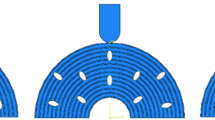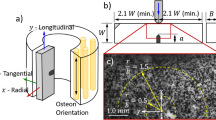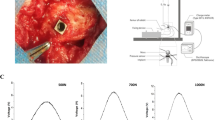Abstract
Deterioration of bone is a progress of damage accumulation in the form of microcracking spanning a wide range of dimensional scales. To examine the microcracking morphology of compact bone subjected to impact loading, non-notched beam specimens of compact bovine femur were loaded with an instrumented Charpy impact system under various impact energy levels. The middle sections of the tested specimens was examined the by Frost’s basic funsion technique by Frost (Med Bull 8:25–35, 1960) to investigate the microcracking morphology. The effects of size of osteon on the mechanical integrity of ostoen structure were also investigated by using of a finite element modeling (FEM), micromechanics, and constrained optimization method. The damage mechanism and energy dissipation were analyzed.
Access provided by Autonomous University of Puebla. Download conference paper PDF
Similar content being viewed by others
Keywords
17.1 Introduction
According to their shapes, bone can be classified as long bone, flat bone, short bone, and et al. Femur and tibia are two typical long bones, which are the major support of vertebrates. The diaphysis of long bone is made of dense cortical bone, and the two ends, called epiphysis, are made of phony trabecular bone. In microstructure level (from 10 to 500 μm) [2], the primary continent of mature cortical bone (also called osteon bone) is osteon system, which grows along the loading axis and comprises center Haversian system surrounded by cylindrical lamellae formed by collagen fibrils and embedded mineral in nanostructure level (from a few hundred nanometers to 1 μm). The boundary between osteons and surrounding bone tissue, called cement line, exhibits brittle properties due to its high mineral composition. Unlike osteon bone, immature bone (laminar bone) is characterized with laminar structure. The osteon structure of bone is like a fiber-reinforced composite with hard fiber (osteon) distributed in the soft interstitial bone matrix. This unique hierarchical structure contributes bone’s tough but light weight properties. The morphology and composition of osteonal cement line in human bone has been studied by Schaffler [3].
The research interest is to investigate the significant benefits the unique osteon structure and the effects of hierarchical structure such as the size, density, distribution, and properties of oseon on the overall mechanical function of bone. During their life span, bone consistently undergoes targeted and non-targeted remodeling [4] in order to assure its functional integrity. Non-targeted remodeling is bone adaption to meet metabolic needs, and targeted remodeling is triggered by microdamage induced in daily fatigue activities. Understanding the microcracking morphology and its relation to applied loading is of great clinical interest to better study targeted remodeling in bone.
The objectives of the paper are to investigate the significant benefits of unique osteon structure and its failure mechanism and microcracking morphology when subjected to impact loading. A Charpy impact testing on non-notched beam bone specimens were performed by use of an instrumented Charpy impact system. The post-failure examinations were achieved by a bright field microscope. The commercial software, ABAQUS, was used to model ostoen bone subjected to dynamic loading in micro-level, and the optimization tool, MatLab fmincon and Heeds will be used to optimize the size and area percentage of ostoen to obtain an optimal ostoen structure.
17.2 Material and Methods
All the specimens were machined out of fresh compact bovine femurs (60 months old) provided by a local beef abattoir. The mid-diaphysis of the bovine femur was cut into rectangular specimens. During the entire machining process, the specimens were kept wet with phosphate buffered saline (PBS) solution. After machining, the specimens were covered with gauge dipped in PBS solution and preserved in a −20 °C freezer until testing. Specimens were thawed prior to testing.
The dimensions of bone specimens are shown in Fig. 17.1. To examine the microcracking morphology and its effects on targeted remodeling of compact bone subjected to impact loading, non-notched beam specimens of compact bovine femur were loaded with an instrumented Charpy impact system under different impact energy levels. A table-on Charpy impact system with light impact mass (0.6 Kg) were designed to perform low energy (ranging from 0.1 to 2.3 J) impact tests on bone specimens. In each energy level, four specimens were tested. The preliminary tests showed that specimens most likely reach failure at around 0.6–0.7 J. After test, one piece of the broken specimen was soaked in basic funsion solution according to Frost’s basic funsion technique. The other piece was preserved in freezer for further experiments. After bulk stain, a ground section (thickness, 300 μm) were cut off the end where is close to the fracturing end. The surface interested is the cross section surface which is perpendicular to ostoen direction. The thin sections then were first polished by a Leco wafering saw with a precision of 0.01 mm followed by final polishing by a Leco lapcloth polishing machine with precision of 1 μm. The other piece without bulk stain followed the same preparing procedures for ground section with bulk stain and the fine polished thin sections will be used as the substrates of cell cultures for evaluating the microcraking effects on osteoclast and osteoblast adhesion [5].
ABAQUS explicit was used to simulate osteon bone structure subjected to impact loading in micro-level. Osteon bone is of unique microstructure with hard fiber-like ostoen deposited in the soft interstitial bone matrix. This unique structure not only provides a nutrition nets connecting to the bone marrow, but also creates an orthotropic composite material with a higher Young’s modulus and strength along the longitudinal direction which is the growing direction of ostoen or the loading axis compared to the transverse direction which is perpendicular to loading axis [6]. The diagram of the cross-section of osteon bone is shown in Fig. 17.2. Osteon with central hole, cement line, and interstitial bone matrix are the three major components of osteon structure. To simplify computation, the liquid inside the Harvension hole was neglect. The dimension, properties, and density of osteon are expected to have a strong correlation to the overall mechanical function of osteon bone. The mechanical properties of osteon bone were treated as a function of these three components. Young’s modulus, yield strength, and stiffness of each this component were used as inputs to FEM. An optimization computation by MatLab fimincon and commercial optimization tool, Heeds, will be performed to examine the optimal ostoen dimension and properties. The diagram for the FEM modeling is shown in Fig. 17.2. The dimension of rectangular osteon piece simulated is 500 × 375 μm, and the diameter of the central canal is 30 μm. The width of the cement line is 5 μm. The average of diameter of the ostoen is about 192.7 μm.
17.3 Results and Discussion
17.3.1 Experimental Results
The impact energy was set up to be 0.14, 0.31, 0.41, 0.53, and 0.67 J respectively. Four specimens were tested in each energy level. It was found that there was no specimen fractured at impact energy of 0.14 J, one specimen fractured at impact energy of 0.31, 0.41, and 0.53 J respectively, and three specimens fractured at the impact energy of 0.67 J. The correlations of the microcracking numbers to the area percentage occupied by secondary osteon and the impact energy applied are shown in Fig. 17.3. The post-failure examinations showed that no microcracks were visible when the specimen was not broken. The cracks in the fractured specimens were linear and were usually larger than hundreds of micrometers in length (Fig. 17.4c). Figure 17.3a showed that no specimens fractured or no microcracks were observed when the area occupied by secondary ostoen is larger than 25 %. It seems that the threshold energy varied for each specimen. When the applied energy between 0.31 to 0.53 J, the fracture possibility of specimens is random (Fig. 17.3b) and may rely on the microstructure of bone. The testing showed that osteon bone (Fig. 17.4a) can sustain higher impact energy compared to the laminar bone (Fig. 17.4b).
17.3.2 FEM Results
In the future, an optimization procedures using commercial FEM software ABAQUS explicit and optimization software Heeds will be performed to evaluate the effects of osteon size and distributions on the overall mechanical properties of osteon bone. The role of cement line, soft interlayer on the mechanical integrity of the osteon bone will also be investigated. Figure 17.5 Shows a preliminary results of the simulation.
17.4 Conclusion
The microcracking morphology of compact bone subjected to impact loading was investigated by an instrumented Charpy impact system under different impact energy levels. The experiments showed that osteon bone can sustain higher impact energy compared to the laminar bone. Optimization of ostoen bone structures will be performed in the future study.
References
Frost HM (1960) Presence of microscopic cracks in vivo in bone. Henry Ford Hosp Med Bull 8:25–35
Rho JY, Kuhn-Spearing L, Zioupos P (1998) Mechanical properties and the hierarchical structure of bone. Med Eng Phys 20:92–102
Schaffler MB, Burr DB, Frederickson RG (1987) Morphology of the osteonal cement line in human-bone. Anat Rec 217:223–228
Parfitt AM (2002) Targeted and nontargeted bone remodeling: relationship to basic multicellular unit origination and progression. Bone 30:5–7
Rumpler M, Wurger T, Roschger P, Zwettler E, Peterlik H, Fratzl P, Klaushofer K (2012) Microcracks and osteoclast resorption activity in vitro. Calcif Tissue Int 90:230–238
Huja SS, Beck FM, Thurman DT (2006) Indentaiton properties of young and old osteons. Calcif Tissue Int 78(6):392–397
Acknowledgements
The authors wish to thank Steven Utz and Peter Howes for helping to machine the specimens.
Author information
Authors and Affiliations
Corresponding author
Editor information
Editors and Affiliations
Rights and permissions
Copyright information
© 2014 The Society for Experimental Mechanics, Inc.
About this paper
Cite this paper
Zhang, W., Tekalur, S.A., Zhong, Z. (2014). Microcracking Morphology and Structure Optimization of Compact Bovine Bone Under Impact Loading. In: Barthelat, F., Zavattieri, P., Korach, C., Prorok, B., Grande-Allen, K. (eds) Mechanics of Biological Systems and Materials, Volume 4. Conference Proceedings of the Society for Experimental Mechanics Series. Springer, Cham. https://doi.org/10.1007/978-3-319-00777-9_17
Download citation
DOI: https://doi.org/10.1007/978-3-319-00777-9_17
Published:
Publisher Name: Springer, Cham
Print ISBN: 978-3-319-00776-2
Online ISBN: 978-3-319-00777-9
eBook Packages: EngineeringEngineering (R0)









